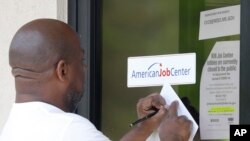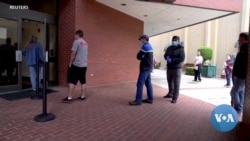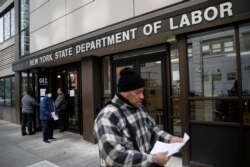Another 6.6 million U.S. workers filed for unemployment compensation last week as the coronavirus pandemic continues to wreak havoc on the American economy, the U.S. Labor Department reported Thursday.
The new figure pushed the three-week total to more than 16 million workers looking for financial assistance, with millions more laid-off employees expected to file claims in the coming weeks as businesses large and small shut their operations or severely limit them.
The total of 6.6 million new claims was only slightly less than the revised 6.8 million figures from two weeks ago. But the back-to-back figures were the two highest since the Department of Labor started tracking the data in 1967.
With federal authorities recommending that Americans maintain at least a two-meter physical distance with other people through the end of April, businesses have been forced to curtail work or shutter operations. They then have laid off workers.
The rapid pace of layoffs is virtually unprecedented in recent U.S. history, although the extent of the economic damage is not precisely known. It took two years during the Great Recession in the 2008-2009 period for 8.6 million people to lose their jobs.
Numerous economic forecasters say the U.S. economy has already plunged into a recession.
Despite the vast number of layoffs, about a tenth of the U.S. labor force, Treasury Secretary Steven Mnuchin voiced optimism that U.S. businesses could be “open for business” sometime in May.
He told CNBC, “I think as soon as the president feels comfortable with the medical issues, we are making everything necessary that American companies and American workers can be open for business, and that they have the liquidity they need to operate their business in the interim.”
But Vice President Mike Pence struck a more cautious tone Wednesday night when asked if the country will be “up and running” by May 1.
“In terms of when we can reopen America, I would just say to you I wouldn’t speculate on a date, but I can assure you that that’s in the hands of the American people,” Pence told Fox News.
“If every one of us will continue to do and implement the president’s coronavirus guidelines for America … we’ll reach that day much sooner than people thought in the beginning of this outbreak,” Pence said.
Gov. Andrew Cuomo of New York, the northeastern state with the most U.S. coronavirus deaths, said the current impact on his state has been more pronounced financially than the 9/11 terrorist attacks nearly two decades ago.
“We have never seen the financial devastation done to the state budget the way it has happened here," Cuomo said. "In my lifetime, go back to 9/11, which was the catastrophic event. This is more devastating to the New York economy and budget than 9/11, by far.”
The U.S. unemployment rate in March was 4.4% but that figure was mostly derived from employment surveys in the early part of the month before most of the layoffs occurred. The survey for April covering the current layoffs will not be released until early May.
Last week’s employment report said the U.S. economy, the world’s largest, shed 701,000 jobs in March. By comparison, 2.6 million jobs were lost in 2008 in the steep recession more than a decade ago and the unemployment rate topped out at 10.2% in October 2009.
Some U.S. economists are predicting that 25 million to 40 million workers out of the U.S. labor force of nearly 165 million could be laid off by July.
The wave of claims by the newly unemployed has overwhelmed some state agencies that handle the paperwork, with the jobless workers forced to wait hours in line at offices or online if they were filing electronically. Jobless claim websites in some states, including New York and Oregon, have crashed in the wave of claims.
Retail stores, restaurants, gyms and the travel industry have been especially slammed by the coronavirus, but layoffs are also increasing in manufacturing, warehousing, transportation and some white-collar professions.
An estimated 190,000 stores have closed, about half of the country’s retail space. Such major retailers as Macy’s, Kohl’s and Gap have collectively laid off 290,000 workers. Other retailers have furloughed thousands more.
Investment banker Goldman Sachs Group has predicted that the U.S. gross domestic product, it output of goods and services will plunge by an annualized 34% in the April-to-June period, compared to its earlier estimate of 24%.
Goldman Sachs economists said the U.S. jobless rate would soar to 15% by mid-year, an estimate that would leave 25 million workers unemployed.
James Bullard, president of the Federal Reserve Bank of St. Louis, Missouri, predicted the unemployment rate may climb to 30% in the second quarter because of the business shutdowns, with a steep 50% drop in the gross domestic product.
Normally, laid-off workers claiming unemployment compensation are paid a fraction of their regular salaries, a sort of stop-gap personal funding.
But the massive $2 trillion coronavirus rescue package that Trump signed into law two weeks ago includes $250 billion for bigger jobless payments that will benefit the newly unemployed at a time when the U.S. economy is facing unparalleled challenges.
The law extends jobless insurance from 26 to 39 weeks and increases the payouts to the jobless by $600 a week for four months above what states would normally pay the unemployed.
In addition, for the first time, freelancers and gig workers, such as Uber drivers, will be eligible.













